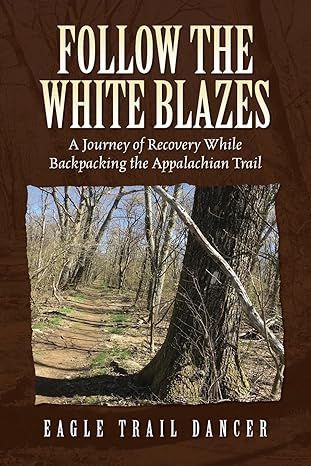Keep Calm and Read On
By Wayne Limberg

At first glance, "Follow the White Blazes,” this month's book selection seemed to be yet another personal account of someone’s completion of the Appalachian Trail (AT). But on opening the book, I realized that this was something different, even special. Yes, it was the story of one man's hike—PATC member Eagle Trail Dancer—of the AT. In this case it was a section hike. But it ran from 1988 to 2023, making it one of the longest on record. Following the white blazes, however, was a metaphor for an even more impressive journey: the author's battle with alcoholism. While the white blazes kept Eagle Trail Dancer on the AT, Alcoholic Anonymous' 12 steps were keeping him sober.
A bit of background: Eagle Trail Dancer is the author’s trail name. He uses it as pen name in keeping with AA's public relations policy, which requires members to maintain their anonymity when it comes to the media. Eagle Trail Dancer does not claim to represent or speak for AA. Nor does he claim to be a therapist or doctor. "Follow the White Blazes" is a personal story. He had two reasons for writing it: give hope to anyone struggling with alcoholism, and shed light on the joys and challenges of backpacking and how it helped him maintain four decades of sobriety.
Eagle Trail Dancer's alcoholism seemed pre-destined. His father returned from WWII with what is now diagnosed at PTSD and turned to alcohol. When he was sober, he was kind and generous. When he drank, he was cruel and abusive to his family. Eventually, Eagle Trail Dancer’s mother also turned to drink. Both parents died as a result of alcoholism.
Eagle Trail Dancer spent most of his childhood trying to avoid his father's wrath and in turn developed PTSD himself. He began drinking in his teens, beginning a downward spiral. By his early 20s, he was an alcoholic, experiencing blackouts, trouble with the law, and serious depression. One night in 1975, he hit bottom and went down on his knees and prayed—and then called AA, which put him in touch with two sponsors who started him on his road to recovery. He had a rocky start. He was not convinced he needed AA, believing that he could handle this drinking problems on his own. He failed and turned in earnest to AA.
The passages on alcoholism and AA are some of the best and most revealing in "Follow the White Blazes." Alcohol remains the most abused substance in America. Eagle Trail Dancer provides valuable insights into the disease and to AA’s approach to combatting it. While he points to genetic and environmental reasons for his drinking problems, at no time does he play the victim. With the help of AA and a belief in “a higher power,” he takes responsibility for his actions and his efforts to find a cure.
One of those cures was the AT. As a child Eagle Trail Dancer took refuge during the summers on this grandparents’ Pennsylvania farm. The first chapter in "Follow the White Blazes" is an account of those times titled "A Spark of Mountain Fever." That spark never died. October 1988 found Eagle Trail Dancer at the AT crossing of Route 522 outside Front Royal starting a hike in Shenandoah national Park (SNP). It would turn out to be a trial-and-error learning experience in terms of gear, weather, food, and water. In the beginning, he never intended to section hike the entire trail but after a few longer backpacking trips, he realized it was possible. His first excursions were in Virginia and Maryland.
He soon developed a routine where he hiked once or twice a year with some trips heading north and some south. He learned about shuttle services and found some hiking partners, but for the most part preferred being on the trail alone or "independently together” when walking with a friend. With 35 years on the trail, Eagle Trail Dancer saw a lot of changes. Never an ultra-lite hiker, his pack dropped a good 20 pounds over the years. Half his time on the trail was pre-cellphone. His advice on food, first aid, safety and training are on target as are as his notes on the history of the AT.
Eagle Trail Dancer discloses that he never liked writing in school because of his learning disabilities. Like his sobriety and completion of the AT, his book is striking testimony to his ability to overcome challenges. His writing style is straightforward and anecdotal. He also salts his prose with poems at times. Some maps, additional photos, and an index would have been useful additions. Gear, first aid, and food lists might have been included in appendices rather than in the text itself. Still, "Follow the White Blazes" is a good introduction to anyone considering section hiking the AT. Eagle Trail Dancer gives shout outs to PATC and other trail clubs; it would have been good to hear more about his trail maintenance work with PATC though this may have presented problems in terms of anonymity.
Do you have a good read? If so, send it wplimberg@aol.com. In the meantime, keep reading. See you on the trail.
